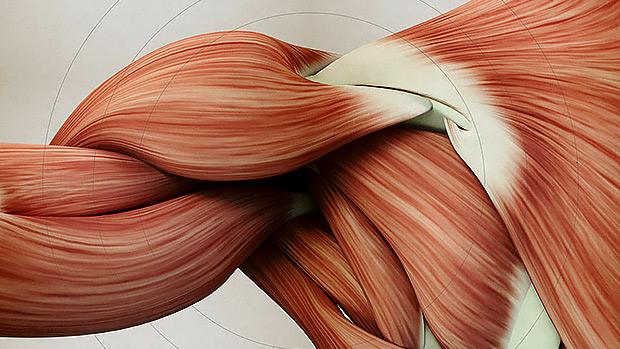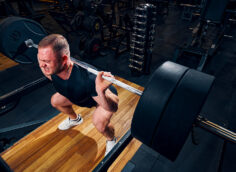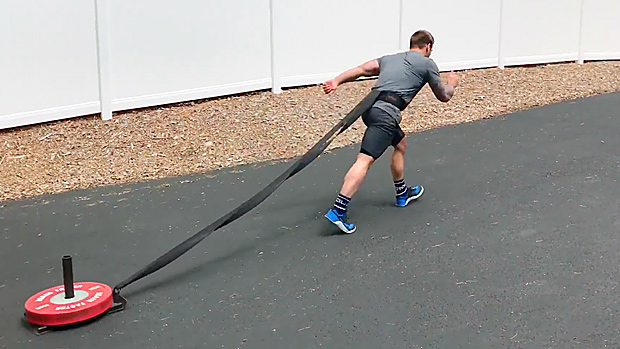The Shoulder Health 10 (SH10) program involves 10 supplementary exercises that address the three most significant causes of preventable shoulder problems:
- Decreased strength
- Increased fatigue
- Lack of mobility
Here's what to remember:
- Maintain strict form.
- Mentally focus on the working muscles in each exercise.
- Many of the exercises use an NT Loop Mini Band. Use the red one, which is the lightest tension, to perform them. The exercises are ideally matched with these bands because their lightweight fabric design makes them much more comfortable and stable than traditional rubber bands. You can use a heavier band as long as you choose a tension that allows you to perform the minimal number of reps indicated with good form.
- Go as far as you can into the top of the range of motion without forcing it.
- If an exercise causes pain or discomfort beyond the expected muscle fatigue, skip it and move on to the next exercise.
Do one set of each exercise, back-to-back, resting as little as possible between exercises, but definitely not longer than 60 seconds.
1. Reach, Roll, and Lift
This is great for building strength-stability in an end-range position. The position of the exercise makes it very difficult to cheat and the action involved is great for targeting the lower traps (1), which have a key role in stabilizing the scapula. (2)
Perform 4 to 6 reps on each side.
2. Quadruped Half-Handcuff Lifts
This improves the stability and mobility of your shoulders in internal rotation movements, along with improving your scapular control.
It's important to keep your working side elbow bent at a 90-degree angle when doing this one and the video demonstrates a really cool and unique trick I developed where the band helps you maintain the proper arm position.
Do 4 to 6 reps on each side.
3. T-Spine Rotations with Hand Behind Back
This one flows perfectly from the previous exercise because it not only involves a similar position, but also utilizes the same mini-band trick to keep your elbow in proper position. This movement also improves shoulder internal rotation strength and mobility while mainly focusing on thoracic spine mobility.
Perform 4 to 6 reps on each side.
4. Prone Behind the Heads
This exercise not only blends the Shoulder Y and Shoulder W into one movement, but passing the band behind your head gives you feedback and ensures you hit the end range of motion on each rep.
Pulling the band slightly apart brings in some lats while the overhead position targets the lower traps. The bottom position of each rep, however, really targets the external rotation strength and mobility of the shoulder.
Do 6 to 8 reps.
5. Mini-Band Arm Walk Outs
The previous exercises work on your shoulder flexion strength and mobility while the arms are overhead. This one builds shoulder extension strength and stability in the overhead position. Not only is it tougher than it looks, it also provides a tremendous challenge to your abs.
Perform 6 to 8 reps.
6. Lateral Hand-Shift Plank
Keep the band around your wrists as in the previous movement, but transition to a push-up position by lifting your knees off the ground. Aside from the obvious challenge to your abs in keeping your torso from twisting or sagging, alternately shifting from one hand to the other forces the shoulders to stabilize the body. Further, the use of the band enhances the demand on the posterior shoulder muscles.
Perform 12 to 15 reps on each side.
7. 90/90 External Rotations
Shoulder external rotation exercises primarily target and strengthen the supraspinatus and external rotators (infraspinatus and teres minor). These exercises are popular in rehab settings because strengthening the supraspinatus and infraspinatus is a common focus of shoulder rehabilitation programs.
Now, some trainers like to assert that targeted shoulder external rotation exercises are a waste of time, but I don't agree. Research has shown that isolated external rotation at the 90/90 position is one of the best ways to facilitate the supraspinatus. (3)
Do 12 to 15 reps on each side.
8. 90/90 Alternate-Arm Reverse Flye
This one basically acts as a reverse pec dec without the need for the machine. This mainly targets the rear delts while also demanding some work from the shoulder external rotators to maintain the 90/90 arm position.
Perform 12 to 15 reps on each side.
9. No Moneys
I got this one from Eric Cressey years ago. It's one of the best exercises for external rotator muscle activation (3). It allows you to train your external rotators both with your arms elevated, as in exercise number 7, and with your arms by your side.
Do 12 to 15 reps.
10. Alternate Arm I's
This one trains your scapular musculature in end-range shoulder extension by making you keep your arms low, next to your torso, while driving them backwards. What's cool about this exercise is how the band provides resistance where you need it the most.
Perform 12 to 15 reps.
How Often Should I Do It?
No fewer than two times a week, but no more than five times per week.
When Should I Do It?
You have a few choices here:
- Prior to your sport practice as an effective pre-performance warm-up.
- As active recovery between your strength and conditioning workouts.
- As a workout cool down, after you've done regular compound and isolation exercises.
How Long Does It Take?
Once you're familiar with how to properly perform each exercise, it should take you no more than 15 minutes.
The exercises have been carefully sequenced. You begin with the bodyweight exercises and then move on to the mini-band exercises. Plus, all of the exercises transition smoothly from one to another, which makes them easy to memorize while maximizing your training time.
- Ekstrom RA, Donatelli RA, Soderberg GL. Surface Electromyographic Analysis of Exercises for the Trapezius and Serratus Anterior Muscles. Journal of Orthopaedic & Sports Physical Therapy. 2003; 33(5): 247–258.
- Cools A, Declercq G, Cambier D, et al. Trapezius activity and intramuscular balance during isokinetic exercise in overhead athletes with impingement symptoms. Scand J Med Sci Sports. 2007;17:25–33.
- Pabian, Patrick & Kolber, Morey & McCarthy, John. (2011). Postrehabilitation Strength and Conditioning of the Shoulder: An Interdisciplinary Approach. Strength & Conditioning Journal. 33. 42-55.
T Nation earns from qualifying purchases as an Amazon Associate. Read more about our policy.




